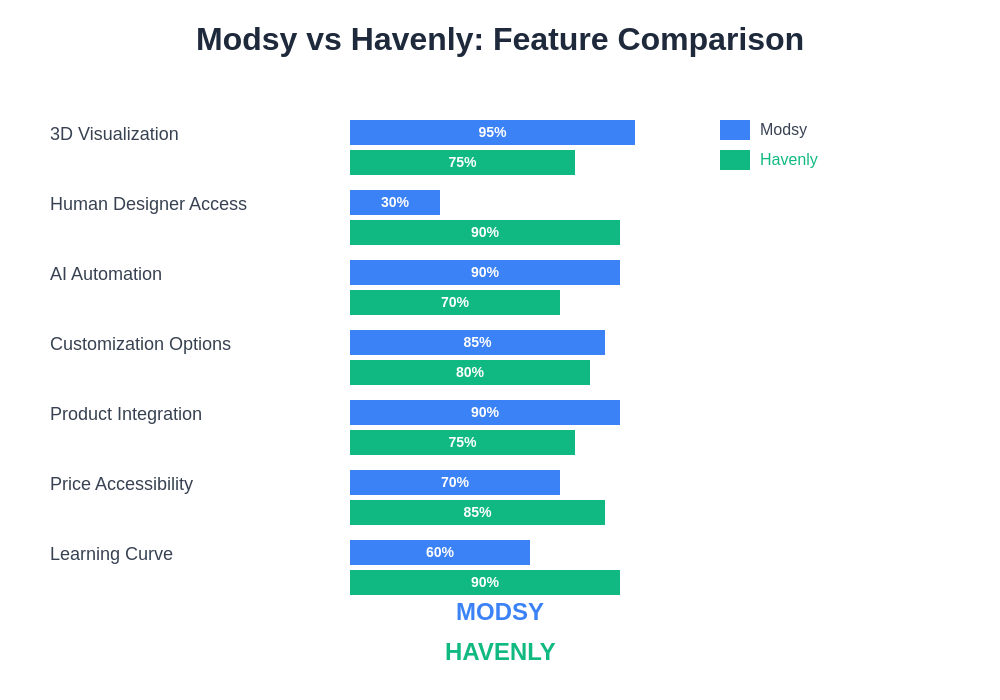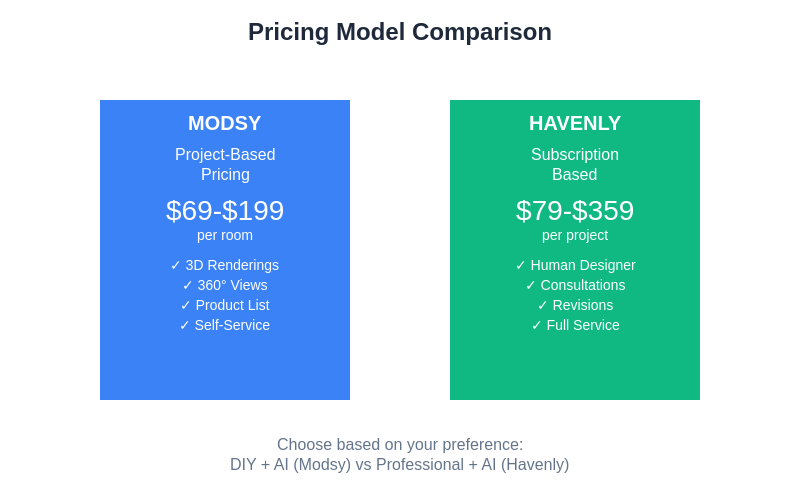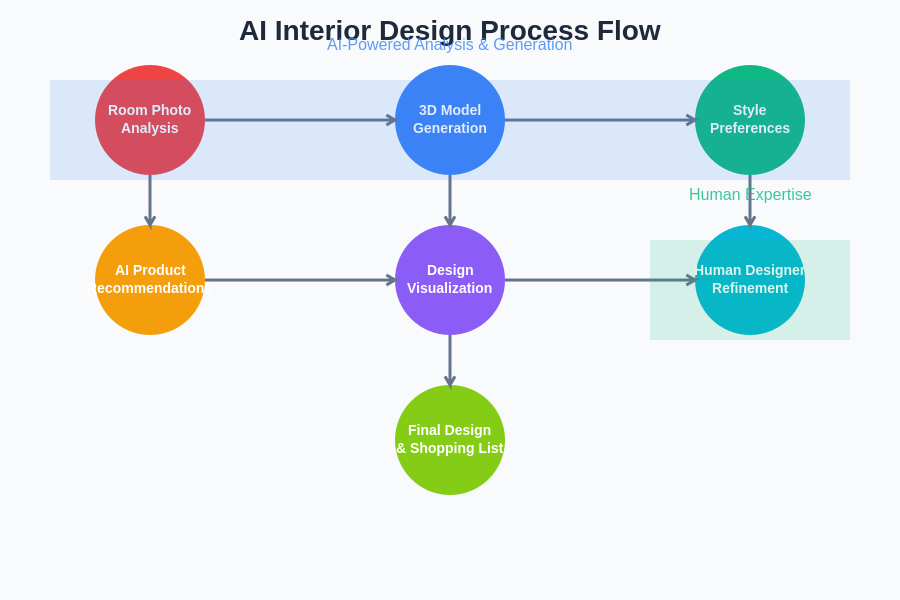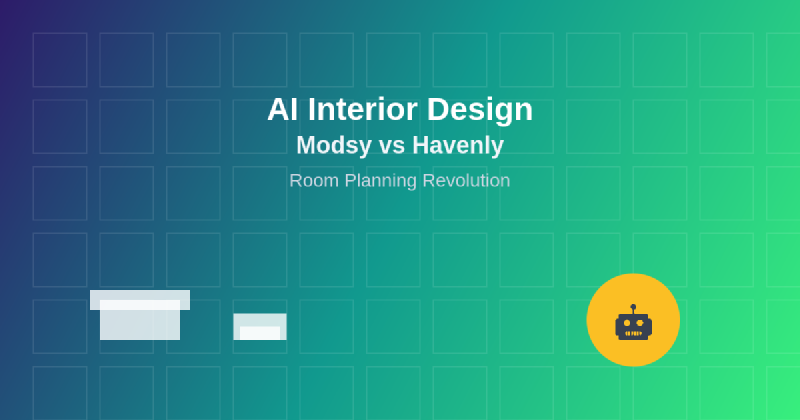The revolution in interior design has been dramatically accelerated by artificial intelligence, transforming how homeowners and professionals approach room planning, furniture selection, and space optimization. Among the leading platforms in this digital transformation, Modsy and Havenly have emerged as prominent players, each leveraging AI technology to democratize professional interior design services and make sophisticated room planning accessible to consumers worldwide.
Explore the latest AI trends in design and creativity to discover how artificial intelligence is reshaping creative industries beyond traditional boundaries. The intersection of AI and interior design represents a fascinating convergence of technology and aesthetics, where machine learning algorithms analyze spatial relationships, color harmonies, and style preferences to generate personalized design solutions that were once the exclusive domain of professional designers.
The AI-Powered Interior Design Revolution
The traditional interior design process has historically been characterized by lengthy consultations, expensive professional fees, and significant time investments that often placed quality design services beyond the reach of average homeowners. AI-powered platforms have fundamentally disrupted this model by automating many aspects of the design process, from initial room analysis to furniture selection and placement optimization. These technological advances have created new possibilities for accessible, affordable, and highly personalized interior design experiences.
The integration of computer vision, machine learning, and 3D rendering technologies has enabled platforms like Modsy and Havenly to analyze room dimensions, understand spatial constraints, interpret style preferences, and generate realistic visualizations of proposed designs. This technological foundation has transformed abstract design concepts into tangible, interactive experiences that allow users to visualize their spaces before making significant purchasing decisions.
Modsy: Comprehensive 3D Visualization Platform
Modsy has positioned itself as a comprehensive AI-driven interior design platform that emphasizes photorealistic 3D room renderings and extensive customization capabilities. The platform utilizes advanced computer vision technology to analyze uploaded room photos, automatically detecting architectural features, measuring dimensions, and creating accurate 3D models that serve as the foundation for design proposals. This technological approach enables users to see exactly how furniture pieces and design elements will appear in their specific spaces.
The platform’s AI algorithms analyze millions of design combinations to generate personalized recommendations based on user preferences, room constraints, and budget considerations. Modsy’s technology can identify optimal furniture placement, suggest complementary color schemes, and recommend products that match both aesthetic preferences and functional requirements. The platform’s extensive product database includes items from major retailers, providing users with direct purchasing options for recommended pieces.
Experience advanced AI design capabilities with Claude for creative projects that require sophisticated reasoning and design thinking. The combination of AI analysis and human design expertise creates powerful synergies that enhance both the efficiency and creativity of the design process.
Havenly: Human-AI Collaborative Design Approach
Havenly has developed a unique approach that combines artificial intelligence with human design expertise, creating a hybrid model that leverages the efficiency of AI while maintaining the creative intuition and personal touch of professional designers. The platform uses AI to streamline the initial design process, analyzing user preferences, space requirements, and budget constraints to generate preliminary design concepts that are then refined and personalized by human designers.
The platform’s AI system excels at pattern recognition and preference analysis, learning from user feedback to improve recommendation accuracy over time. Havenly’s technology can identify design trends, analyze color compatibility, and suggest furniture arrangements, but the final design decisions are made by experienced interior designers who can incorporate subjective elements like personal taste, lifestyle considerations, and unique spatial challenges that purely algorithmic approaches might miss.
Feature Comparison and Technological Capabilities
The technological approaches employed by Modsy and Havenly reflect different philosophies regarding the role of AI in creative processes. Modsy’s platform emphasizes automation and self-service capabilities, providing users with sophisticated tools for independent design exploration and visualization. The platform’s 3D rendering engine generates highly detailed visualizations that allow users to experiment with different design options, view rooms from multiple angles, and even experience virtual reality walkthroughs of proposed designs.

Havenly’s technology focuses on facilitating human-AI collaboration, using machine learning to enhance designer productivity and improve client matching accuracy. The platform’s AI analyzes client preferences and designer portfolios to optimize pairing decisions, ensuring that each client works with a designer whose style and expertise align with their specific needs and preferences. This approach leverages AI’s analytical capabilities while preserving the creative and empathetic elements that human designers bring to the process.
User Experience and Interface Design
The user experience design of both platforms reflects their underlying technological philosophies and target user demographics. Modsy provides an intuitive, self-guided experience that empowers users to explore design options independently through interactive 3D environments and comprehensive customization tools. The platform’s interface prioritizes visual feedback and real-time manipulation capabilities, allowing users to see immediate results as they experiment with different design elements.
Havenly’s interface emphasizes communication and collaboration features, providing streamlined tools for client-designer interaction, project management, and design iteration. The platform’s user experience is designed to facilitate meaningful conversations about design preferences, lifestyle requirements, and aesthetic goals, supporting the human-centered approach that distinguishes Havenly’s service model from purely automated alternatives.
Pricing Models and Value Propositions
The pricing strategies employed by these platforms reflect their different approaches to service delivery and target market positioning. Modsy operates on a project-based pricing model that provides users with specific deliverables including 3D renderings, product recommendations, and shopping lists for recommended items. This approach appeals to users who prefer clear, upfront pricing and defined project scope, making it particularly suitable for specific room redesigns or targeted design challenges.
Havenly utilizes a tiered subscription model that provides different levels of designer access and service intensity based on user needs and budget considerations. This approach allows for more flexible engagement models, from basic design consultations to comprehensive full-room makeovers, enabling users to select service levels that match their specific requirements and financial constraints.

The distinct pricing approaches reflect the fundamental differences in service delivery models, with Modsy focusing on technology-driven self-service solutions and Havenly emphasizing personalized professional design services enhanced by AI capabilities. These pricing structures enable users to select the option that best aligns with their budget, time constraints, and desired level of professional involvement in the design process.
Discover comprehensive AI research capabilities with Perplexity for gathering detailed market analysis and design trend information that can inform interior design decisions. The integration of multiple AI tools creates comprehensive research and analysis capabilities that support informed design choices.
AI Technology and Machine Learning Applications
The machine learning technologies underlying both platforms represent sophisticated applications of artificial intelligence in creative domains. Modsy’s computer vision systems can analyze room photos to extract detailed spatial information, identify furniture pieces, and understand architectural features with remarkable accuracy. The platform’s recommendation engine utilizes collaborative filtering and content-based algorithms to suggest design elements that align with user preferences while considering practical constraints like budget and space limitations.
Havenly’s AI systems focus on preference analysis and designer matching, using natural language processing to understand client requirements expressed in conversational formats and machine learning algorithms to identify optimal client-designer pairings based on historical project outcomes and style compatibility. The platform’s technology continuously learns from user feedback and project results to improve matching accuracy and design quality over time.

The comprehensive AI design process demonstrates how machine learning algorithms analyze multiple data points simultaneously, from spatial constraints and style preferences to budget considerations and functional requirements, creating a sophisticated framework for generating personalized design solutions that align with individual user needs and aesthetic preferences.
Market Position and Competitive Advantages
Both platforms have established distinct competitive positions within the AI-powered interior design market through their unique technological and service approaches. Modsy’s comprehensive self-service platform appeals to tech-savvy users who appreciate detailed visualization capabilities and prefer to maintain control over design decisions while benefiting from AI-powered recommendations and optimization suggestions.
Havenly’s human-AI hybrid model attracts users who value personal attention and creative collaboration while still benefiting from AI-enhanced efficiency and accuracy. This approach has proven particularly effective for complex design challenges that require subjective judgment, cultural sensitivity, and creative problem-solving capabilities that purely algorithmic approaches may struggle to address effectively.
Integration with E-commerce and Retail Platforms
The integration capabilities of these platforms with major furniture retailers and e-commerce systems represent crucial differentiating factors that impact user experience and platform utility. Modsy has developed extensive partnerships with furniture manufacturers and retailers, enabling seamless integration between design recommendations and purchasing options. The platform’s product database includes detailed specifications, pricing information, and availability data that facilitate informed purchasing decisions.
Havenly’s approach emphasizes curated product selection and designer expertise in sourcing unique pieces that may not be readily available through mainstream retail channels. The platform’s designers leverage their industry relationships and product knowledge to recommend items that align with design concepts while considering factors like quality, durability, and long-term satisfaction that extend beyond immediate aesthetic appeal.
Customization and Personalization Capabilities
The degree of customization and personalization offered by each platform reflects their different approaches to addressing individual user needs and preferences. Modsy’s technology enables extensive customization of room layouts, furniture arrangements, color schemes, and decorative elements through interactive 3D interfaces that provide immediate visual feedback. Users can experiment with countless design variations and see real-time updates as they modify different aspects of their room designs.
Havenly’s personalization approach emphasizes understanding user lifestyle requirements, aesthetic preferences, and functional needs through detailed consultations and ongoing communication with assigned designers. This human-centered customization process can address nuanced requirements and subjective preferences that may be difficult to capture through purely algorithmic approaches, resulting in designs that reflect individual personality and lifestyle considerations.
Technology Scalability and Future Development
The technological foundations of both platforms position them for continued evolution and capability expansion as AI technologies advance and user expectations evolve. Modsy’s comprehensive 3D rendering and visualization platform provides a strong foundation for incorporating emerging technologies like augmented reality, virtual reality, and advanced spatial computing capabilities that could further enhance user experience and design accuracy.
Havenly’s human-AI collaborative model offers flexibility for incorporating new AI capabilities while maintaining the human creativity and expertise that differentiates their service approach. The platform’s emphasis on continuous learning and improvement through user feedback creates opportunities for enhancing AI recommendation accuracy and designer productivity through technological advancement.
User Demographics and Target Market Analysis
The user demographics and target markets served by these platforms reflect their different value propositions and service approaches. Modsy tends to attract younger, tech-savvy users who are comfortable with digital tools and prefer self-directed design exploration. The platform’s comprehensive visualization capabilities and extensive customization options appeal to users who enjoy experimenting with design options and want detailed control over the design process.
Havenly’s user base includes individuals who value professional design expertise and personal attention while still appreciating the efficiency and accessibility that AI technology provides. This demographic often includes busy professionals, families with complex lifestyle requirements, and users tackling significant home renovation projects that benefit from professional guidance and creative expertise.
Quality Assurance and Design Standards
Both platforms have implemented quality assurance processes that leverage AI technology to maintain design standards and ensure customer satisfaction. Modsy’s automated quality checks analyze proposed designs for spatial feasibility, aesthetic coherence, and functional optimization, flagging potential issues before designs are presented to users. The platform’s AI systems can identify problematic furniture arrangements, color combinations that may not work well together, and design elements that may not suit specific room characteristics.
Havenly’s quality assurance approach combines AI analysis with human oversight, using technology to support designer decision-making while maintaining human judgment as the final arbiter of design quality. This hybrid approach enables the platform to maintain consistent design standards while accommodating subjective preferences and unique client requirements that may not conform to standard algorithmic recommendations.
Future Trends and Industry Evolution
The continued evolution of AI-powered interior design platforms will likely be influenced by advances in computer vision, natural language processing, and immersive technologies that enhance user experience and design accuracy. Both Modsy and Havenly are well-positioned to incorporate these technological advances while maintaining their distinct approaches to AI-human collaboration in creative processes.
The growing integration of smart home technologies and Internet of Things devices will create new opportunities for AI-powered design platforms to consider functional requirements beyond traditional aesthetic and spatial considerations. Future developments may include AI systems that can optimize room designs for energy efficiency, acoustic performance, and integration with smart home ecosystems, creating more holistic and technologically sophisticated design solutions.
The democratization of professional design services through AI technology will likely continue expanding market accessibility while raising new questions about the role of human creativity and expertise in increasingly automated creative processes. The success of platforms like Modsy and Havenly demonstrates that there is significant market demand for AI-enhanced design services that balance technological capability with human insight and creativity.
Disclaimer
This article is for informational purposes only and does not constitute professional advice. The analysis presented is based on publicly available information about AI interior design platforms and their capabilities. Readers should conduct their own research and consider their specific needs when selecting interior design services. The effectiveness and suitability of different platforms may vary based on individual requirements, preferences, and project scope. Pricing, features, and service availability may change without notice.
